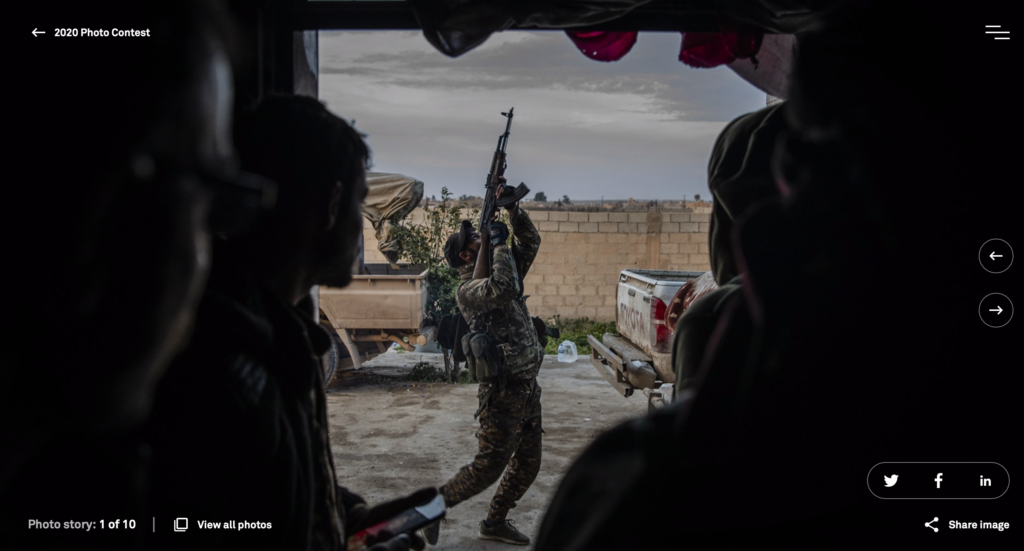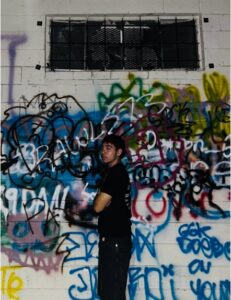Appreciating Photojournalists

I spent hours going through incredible photos, trying to choose just one. Finally, I settled on this image taken in Syria by Ivor Prickett, published by World Press in their Photo of the Year contest. I think that this image truly epitomizes what good photojournalism is, as in my mind, photojournalism is about the story.
One thing that draws me to photojournalism is the humanitarian aspect of it. I was first interested in journalism as a way to help people and bring light to events and people that needed help, which is exactly what this photo does. Shooting important images of crises, such as that of Syria, is what makes photojournalism so important in my mind.
In terms of technique, I find the framing of it incredibly powerful, with the darkened faces watching the soldier, presumably in fear. The way that the photographer chose to shoot from the inside looking out, in order to bring the lighting and focus to the soldier, makes this photo even better. With this, I like that they didn’t brighten the photo too much, and instead left the natural light (coming from above) of the cloudy day, adding to the serious tone of the work. Also, they seemingly used an F-stop between 4-8, blurring out most of the details of the inside faces and drawing the eye to the soldier, which I believe works well for this photo. In terms of timing, I think it makes it all the more intriguing that the photographer waited until the gun was pointed upwards, a much more powerful photo than just a soldier standing or patrolling.
The timing, focus, technique, and subject matter all paired together are what make this photo great. Bringing light to important events such as this is what makes photojournalism what it is. Here in Las Cruces, fortunately, you couldn’t create a photo with as much weight in terms of world events. However, I think that, and I would like to do someday, you could create a powerful imagery set based on homelessness. It isn’t always the technique that makes the photo, but rather, the subject matter. The technique is the cherry on top that brings it all together.
A fuller description of the photo, taken from the website:
“10 February, 2019
A Syrian Democratic Forces (SDF) fighter tries to shoot down an explosives-laden IS drone targeting their position in Baghuz, Syria.
By early 2019, the territory held by the Islamic State group (IS) in Syria had reduced to a four-square-kilometer patch in the southeast, centered on the village of Baghuz. The IS retreat from northern Syria took place under the onslaught of the combined militias of the Syrian Democratic Forces (SDF), led by the Kurdish People’s Protection Units (YPG) and supported by an international coalition of primarily US troops. As IS drew back, tens of thousands of people emerged from the enclave, many of them the wives and children of foreign IS fighters. Numerous IS fighters themselves surrendered or were captured. The Kurds were left with the conundrum of what to do with so many prisoners, many of them under 18 and orphaned or separated from their families. Then, at the beginning of October, US president Donald Trump ordered US troops out of northern Syria. On 9 October, Turkey—which regarded Kurdish forces on its border as a security threat, given the decades-long Kurdish insurgency against Turkey—invaded northern Syria, aiming to end Kurdish control over the territory. As Kurdish forces refocused their attention on a new opponent, the fate of the many thousands of prisoners grew even more uncertain.”
An excerpt about the photographer, also from the website:
“Working exclusively for The New York Times, Ivor Prickett has spent months on the ground reporting in both words and pictures on the fight against ISIS in Iraq and Syria.
The entire body of work titled ‘End of the Caliphate’ was published as a book by Steidl in June 2019. Based in the Middle East since 2009, Prickett documented the Arab Spring uprisings in Egypt and Libya, working simultaneously on editorial assignments and his own long-term projects.
Travelling to more than 10 countries between 2012 and 2015, he documented the Syrian refugee crisis in the region as well as Europe, working in close collaboration with United Nations High Commissioner for Refugees (UNHCR) to produce the body of work, ‘Seeking Shelter’. With a particular interest in the aftermath of war and its humanitarian consequences, his early projects focused on stories of displaced people throughout the Balkans and Caucasus, and culminated in the form of ‘Returning Home’.
Prickett’s work has been recognised through a number of prestigious awards including Pictures of the Year International (POYI), Foam Talent, The Taylor Wessing Portrait Prize, and The Ian Parry Scholarship. His work in Iraq and Syria earned him a place as a finalist in the Breaking News Photography category of the Pulitzer Prize in 2018, and he was shortlisted for the Prix Pictet in 2019.
His pictures have been exhibited widely at institutions such as the Victoria and Albert Museum (London), Foam Gallery (Amsterdam), and The National Portrait Gallery (London).
He is represented by Panos Pictures, and holds a degree in Documentary Photography from the University of Wales Newport.”





